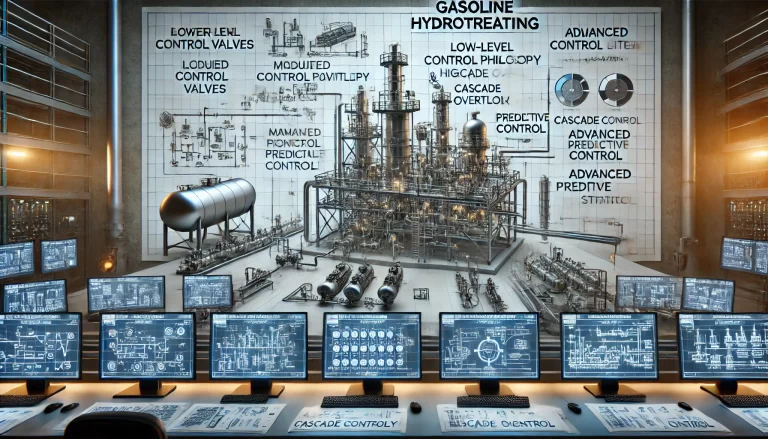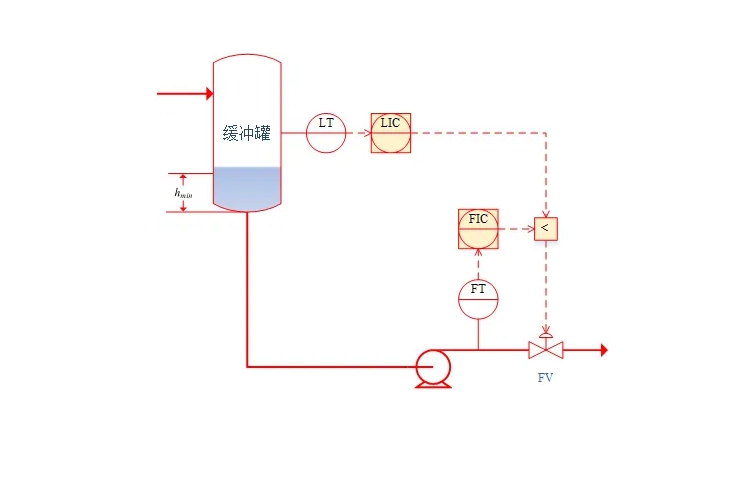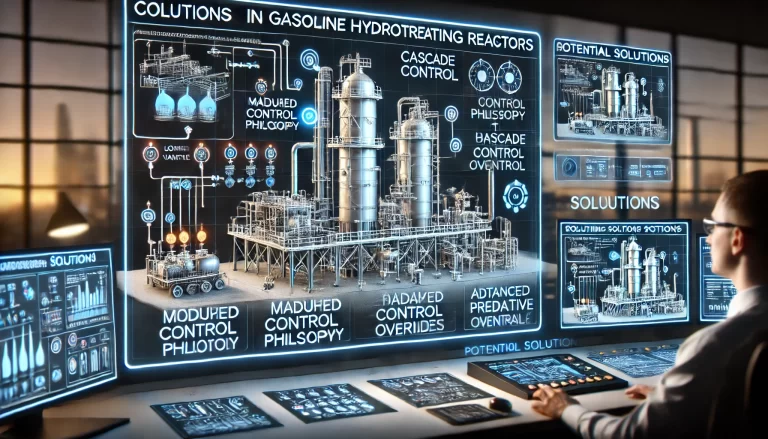Introduction
In the operational analysis of a gasoline hydrotreating unit, it was found that operators frequently needed to adjust the reactor feed manually. This indicates that the existing control scheme does not align well with practical operational requirements. This article reviews the deficiencies of the current design, evaluates its impact, and explores possible solutions to improve process stability and operational safety.
Current Control Scheme and Its Challenges
The original control scheme is illustrated in the diagram (not included here for brevity). The reactor feed flow (FIC) is typically maintained as stable as possible to ensure process efficiency. The upstream buffer tank feed is subject to uncertainties, including variations in plant load and feedstock composition. To meet this process requirement and prevent cavitation of the pump caused by low buffer tank levels, a low-level liquid controller (LIC) was added with a set point of 15%. The LIC output overrides the FIC output to adjust the reactor feed control valve when liquid levels fall below the set threshold.
In practice, however, this approach has several critical flaws:
Limited Buffer Tank Volume: The buffer tank volume is insufficient to absorb significant fluctuations. Uncontrolled upstream flowforces the reactor feed to maintain the balance in the buffer tank.
Feed Control Instability: When the buffer tank level drops below the LIC set point, the FIC is overridden, resulting in erratic feed control. Conversely, high buffer tank levels require increased reactor feed to lower the liquid level, which is only feasible up to the maximum feed limit of the reactor. Beyond this point, reducing the overall plant load becomes the only option.
Violation of Control Principles: The design does not adequately balance the competing priorities of material balance and reactor feed stability. Override control, meant for safety constraints, is being used as a primary control mechanism, which is fundamentally flawed.

Key Considerations for Improved Control
To address these challenges, any proposed solution must:
Maintain Material Balance: Prioritize balancing the buffer tank inflow and outflow.
Ensure Reactor Safety: Prevent both low-level cavitation and high-level overflow.
Minimize Operator Intervention: Reduce the frequency of manual adjustments by operators.
Potential Solutions
Three potential solutions, ranging from simple to advanced, are proposed to address the current limitations:
1. Modify Existing Control Philosophy
Approach: Redefine the FIC as a high-flow safety protection mechanism, allowing the LIC to perform standard liquid level control. Ensure appropriate tuning of the LIC’s PID parameters.
Benefits: This solution does not require significant changes to the control system configuration. Alarm mechanisms should be enhanced for high-level and low-level conditions to provide better operator visibility.
Drawbacks: While this solution is easy to implement, it lacks comprehensive protection for both high and low reactor feed limits.
2. Implement Cascade Control
Approach: Replace the override control with a cascade control strategy. Use the LIC as the primary controller to regulate buffer tank levels, with the FIC acting as the secondary controller to adjust reactor feed. Both controllers should be carefully tuned, and reasonable feed flow limits should be enforced.
Benefits: Provides better feed stability and protection for reactor safety.
Drawbacks: Requires updates to the Distributed Control System (DCS) configuration and slightly more effort for implementation.
3. Adopt Advanced Control Techniques
Approach: Implement advanced control algorithms, such as model predictive control (MPC). Use buffer tank level as the controlled variable and reactor feed as the manipulated variable. Leverage the buffer tank’s capacity to absorb fluctuations, reducing reactor feed disturbances. Establish strict reactor feed limits for additional safety.
Benefits: Offers the most robust solution by combining material balance, process stability, and safety. Advanced control methods can predict disturbances and adjust proactively.
Drawbacks: Requires advanced control software and incurs higher implementation costs. However, no fundamental changes to the existing control strategy are needed.

Comparative Analysis of Solutions
| Solution | Implementation Complexity | Cost | Benefits |
|---|---|---|---|
| Modify Control Philosophy | Low | Minimal | Quick to implement; improves simplicity |
| Cascade Control | Medium | Moderate | Balances level and feed stability |
| Advanced Control | High | Significant | Optimal balance; reduces disturbances |
Practical Insights and Recommendations
Real-world application of these solutions highlights important insights:
Control Strategy Evolution: Control strategies often need iterative refinement. The initial assumption that override control could serve both safety and material balance functions was flawed. Recognizing these limitations has paved the way for more effective alternatives.
Avoiding Oversimplified Techniques: Techniques such as dead-zone PID for range control should be avoided, as they can introduce oscillations due to material imbalances. Advanced control methods offer predictive capabilities that mitigate such issues.
Emphasizing Operator Training: Proper training ensures operators understand the trade-offs of each control scheme and can respond appropriately in edge cases.

Conclusion
Effective control of gasoline hydrotreating reactor feed requires a holistic approach that balances safety, material flow, and operational stability. By iterating on existing designs and leveraging practical insights, process engineers can implement robust solutions that reduce manual interventions and enhance process performance. While advanced control methods offer the most comprehensive improvements, simpler solutions can also provide significant benefits when implemented thoughtfully. Ultimately, the right choice depends on the operational constraints and priorities of the facility.
